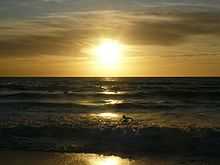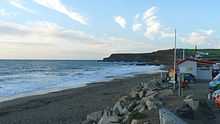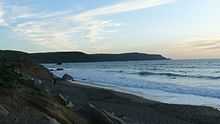Widemouth Bay



Widemouth Bay (Cornish: Porth an Men)[1] is a bay and beach on the Atlantic coast of Cornwall, England, UK. It is about 3 miles (5 km) south of Bude. This stretch of coast is steeped in the smuggling history of times before, and not far south of Widemouth Bay can be found many little inlets and coves.[2]
Activities
The beach is popular for surfing and swimming and is patrolled in the summer by RNLI lifeguards. Several surfing schools operate on the beach because it has relatively gentle, easy to ride waves but on the other hand there can be big waves.[3] There are several cafes on and around the beach as well as a pub and shops on the hill above the bay.
Geography of Widemouth Bay
Widemouth Bay is visually very similar to Southerndown and Ogmore-by-Sea across the Bristol Channel in Wales; it has the same (gently sloping) hill-top location; wide, sandy beach; pounding Atlantic surf; and significantly the same carboniferous sandstone cliffs. Another significant connection is that sloops from Wales would use Widemouth as a port (in the most basic sense), unloading coal and limestone; sloops would take back to Wales Cornish wares such as granite, slate, tin, copper and even Cornish pasties.
Submarine communications cables
The gentle beaches in the bay are also the landing points for many submarine cables that link the UK with other parts of the world. These cables include:
- TAT-3 (USA and UK)
- CANTAT-1 (Canada and UK)
- Apollo (USA)
- TAT-8 (USA and France - last used in 2002)
- TAT-14 (USA and Europe)
- AC-2 (USA)
- EIG (Europe India Gateway)
- GLO-1 (UK and west Africa)[4]
Repeater station
The repeater station is a cable landing station. Construction was begun in 1962 and finished during 1963.[5] The building was specifically constructed to withstand nuclear attack,[6] having numerous specialised features including an air filtration system, five-ton blast doors, and backup power supply systems allowing it to operate as an autonomous building. The majority of the building is constructed below ground, as is common with many blast-resistant bunkers.
References
- ↑ Place-names in the Standard Written Form (SWF) : List of place-names agreed by the MAGA Signage Panel. Cornish Language Partnership.
- ↑ http://www.thisisnorthcornwall.com/widemouth-bay.html
- ↑ http://www.bbc.co.uk/cornwall/content/articles/2005/06/15/bg_widemouthbay_feature.shtml
- ↑ gloworld.com website
- ↑ http://www.bbc.co.uk/history/domesday/dblock/GB-220000-102000/page/2
- ↑ http://www.bbc.co.uk/history/domesday/dblock/GB-220000-102000/page/3
External links
| Wikimedia Commons has media related to Widemouth Bay. |
- Widemouth Bay on the Open Directory Project
- Widemouth Bay surf information and live cam
- Channel 4 News: "Spying, the seaside, sub-sea cables - and Rudyard Kipling" - which includes a report from Widemouth Bay
- Artistic video essay on Widemouth Bay by Richard Broomhall entitled "Scribbling between protons". It reflects on the submarine cables which make landfall at Widemouth
Coordinates: 50°47′N 4°35′W / 50.783°N 4.583°W